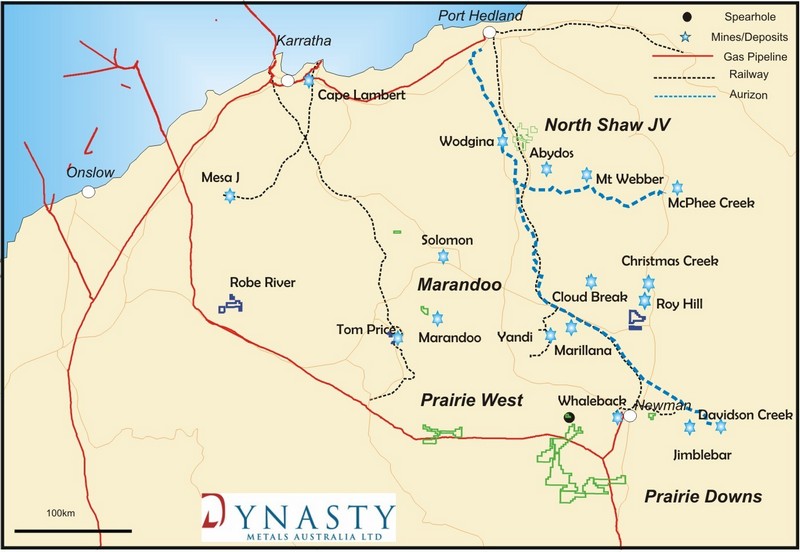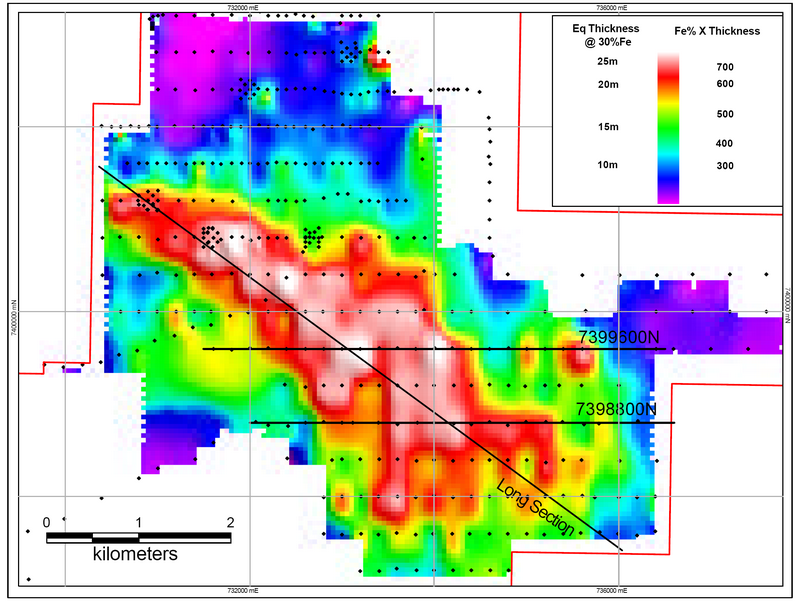Prairie Downs Iron Ore
Dynasty has discovered a JORC-Compliant Inferred Resources of 1.4 billion tonnes of Detrital Channel Iron at Prairie Down’s Spearhole Station, in addition to the 23.3 million tonnes of Marra Mamba Iron Formation.
With such a large resource defined, work on the resource has focused on beneficiation processes following the positive preliminary scoping study in December 2011. The aim is to progress the project towards feasibility studies to take advantage of the potential development of third party infrastructure solutions (Aurizon Rail) over the coming period.
Strategic Location
Strategically located in the prolific iron ore producing Pilbara region, Dynasty’s iron ore project tenements are approximately 40 kilometres south-west of Mt Newman (See Figure 1).
The tenements are all centrally located near to advanced exploration projects and existing mining operations and infrastructure. The Spearhole resource is within 70 kilometres of the proposed Aurizon Rail project which has the potential to unlock several resources in the southern Pilbara region.
Beneficiation
This resource is a unique style of mineralisation with high grade fragments of hematite rich material present within finer grained sand and clay. The source of the high grade material is the extensive outcropping Marra Mamba unit to the west of the tenement. The resource is unconsolidated and will be highly amenable to bulk mining and processing, more similar to a heavy mineral sand deposit than conventional iron ore mining operation.
As such there are many aspects of the beneficiation process that need to be tested and defined and then retested. The early testing indicated a yield of 13-18% with Fe content of greater than 57%. (See Table 1). Current testing is concentrating on maximising the yield and grade and/or reducing the costs of this process. Once complete, the results of this testing can be used to update the positive scoping study completed in December 2011.
Table 1 Beneficiation results summary
| Yield | Fe | SiO2 | Al2O3 | TiO2 | P | |
|---|---|---|---|---|---|---|
|
High Grade |
13-18% |
56-59% |
6.0-7.5% |
5.5-6.5% |
1.7-2.0% |
0.03-0.05% |
|
Mid Grade |
14-18% |
40-45% |
15-20% |
8-12% |
0.5-1.5% |
0.03-0.05% |
The latest testing has concentrated on the following main aspects:
- the unlocking of the Fe within the mid grade material detailed in Table 1
- the potential to increase yield and grade through refining the processing
- reducing processing costs by testing alternative technologies

Figure 1 Strategic location of Dynasty’s Pilbara iron ore projects
Resource Statements
In March 2010, Dynasty announced the following maiden JORC-Compliant Inferred Resources for the Prairie Downs Project:
Table 2 – Inferred Resources - Spearhole Detrital Iron Deposit
| Tonnes Mt | Fe % | CaFe* % | SiO2 % | Al2O3 % | P % | LOI % | Cut-Off Grade % Fe |
|---|---|---|---|---|---|---|---|
|
932 |
27.4 |
29.7 |
34.6 |
14.7 |
0.04 |
7.8 |
>20% Fe |
|
1,400 |
23.5 |
25.5 |
38.6 |
15.5 |
0.03 |
8.1 |
Total Resource |
*Calcined Fe (“CaFe") = Fe/((100-LOI)/100)
Table 3 Inferred Resources - Marra Mamba Deposit
| Tonnes Mt * | Fe % | CaFe % | SIO2 % | AL2O3 % | P % | LOI % | Cut Off Grade % Fe |
|---|---|---|---|---|---|---|---|
|
7.2 |
53.7 |
58.7 |
9.4 |
4.3 |
0.05 |
8.5 |
>50% Fe |
|
23.3 |
44.2 |
48.3 |
21.9 |
5.2 |
0.04 |
8.0 |
Total Resource |
* Marra Mamba Deposit density assumed at 2.8 dry tonnes per cubic metre
The above resources are based on 19,326 metres drilled by Dynasty at its Prairie Downs project between August 2009 and September 2010. The program was of a reconnaissance nature and was designed to test the geological concept that channel iron deposits existed in the valley between BHB Billiton’s Brockman and Marra Mamba Formation deposits to the west and an unnamed Archaean Iron Formation to the east.
Holes were drilled on a 400 metres x 200 metres and 400 metres x 100 metres spacing to a maximum depth of 60 metres and an average depth of 31.5 metres. The maximum depth of iron mineralisation identified during the program was 48 metres.
The resources for the Spearhole deposit, includes all assays from reverse-circulation drill holes SERC001 to SERC184 and SWRC001 to SWRC012.
The resources for the Marra Mamba Hematite Deposit include all assays from reverse-circulation drill holes MMRC001 to MMRC029.
QAQC data were reviewed by Dynasty’s consultants which analytical results included certified reference material, field duplicates and pulp duplicates. Analysis of samples of certified material showed that the analytical accuracy was within the tolerance limits.
The independent laboratory used for the analysis of drill samples was Nagrom, based in Kelmscott, Western Australia.
The Spearhole mineralisation improves towards the south and south-east and deepens at the confluence of two channels. Drilling data included in the above resource estimate is in the northern, shallower portion of the deposits identified so far.

Figure 2 The extensive ironstone gravels in paleochannels as discovered in the 2009 and 2010 drilling program

